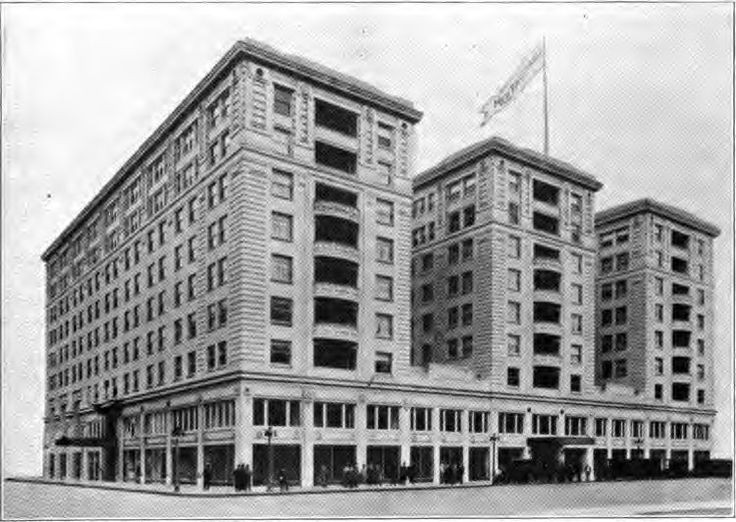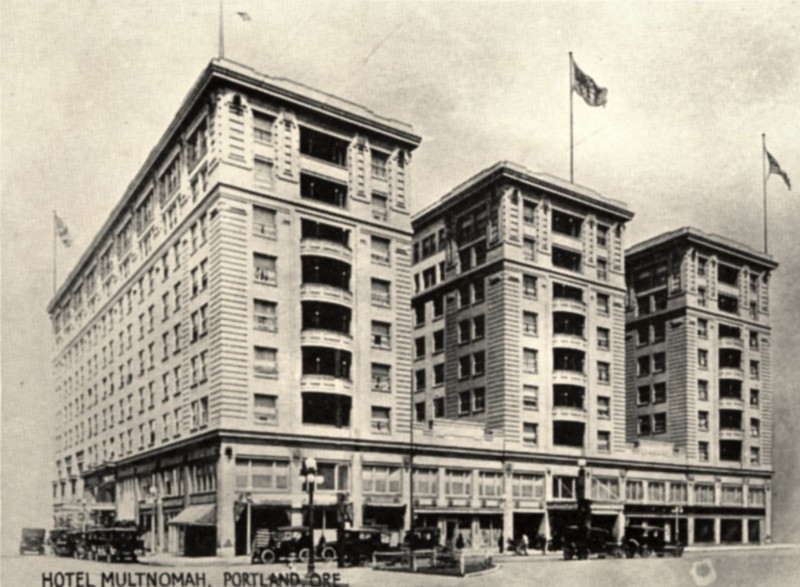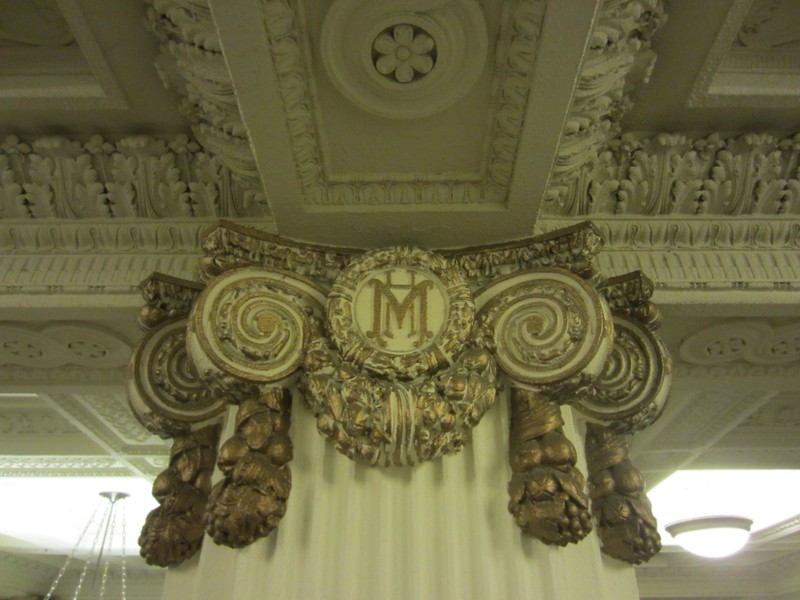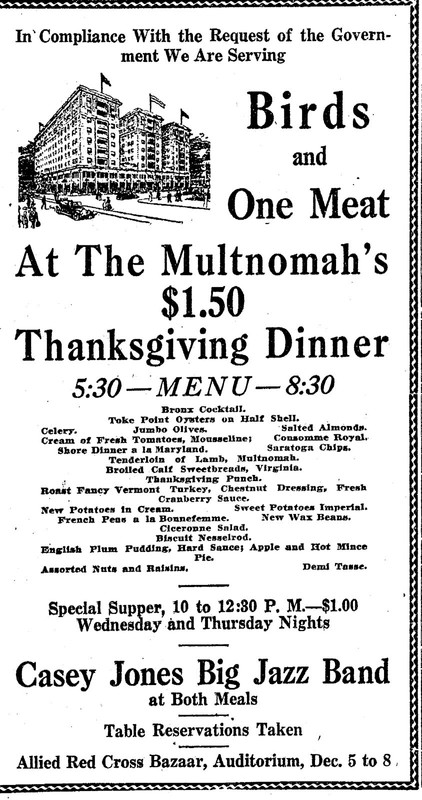Multnomah Hotel
Introduction
Text-to-speech Audio
One of Portland’s most prominent hotels, the Multnomah Hotel (now Embassy Suites), existed as the city's (and one of the region's) largest hotels until the early 1960s. During its heydey, the hotel played home to numerous events, hosted nine U.S. Presidents, Queen Marie of Romania, Charles Lindbergh, Frank Sinatra, Bing Crosby, and Elvis Presley in 1957.
Images
https://s-media-cache-ak0.pinimg.com/736x/58/ea/b8/58eab8fa413032871c010e4de72f258a.jpg

Hotel picture. Source: Many web sources.

Wiki (Creative Commons license)

Wiki (Creative Commons)

https://vintageportland.wordpress.com/2012/11/22/multnomah-hotel-thanksgiving-1917/

Backstory and Context
Text-to-speech Audio
Opened in 1912, the Multnomah Hotel stood as the city's largest for half of a century and hosted nine U.S. Presidents, including John F. Kennedy who gave a speech from a hotel balcony, as well as Queen Marie of Romania, Charles Lindberg, Jimmy Stewert, Bing Crosby, and Elvis Presley.
As a sign of Portland, and the entire Pacific Northwestern Coast's growth plans to build the 750 Multnomah Hotel and the nearby Oregon (Benson) Hotel occurred nearly simultaneously. Far removed from the region's former frontier days, money and wealth, as well as new residents, poured into the area via mining, shipping, and the timber industries
When the hotel opened, 8,000 visitors paraded through the establishment on the first day and more than 1,200 persons dined in one of its nine banquet and dining halls. Visitors witnessed lavish decor and a host of new technology, all symbols of the overall trend in technological advancement associated with the 2nd Industrial Revolution. For instance, guests would have seen exotic wood furniture, 70,000 square yards of carpeting, and plenty of decorative motifs Moreover, the hotel offered an early form of air-conditioned, cooler air provided by a system from which ice water was routed through the steam heating system in the summer.
The bells and whistles spoke to the hotel's design as a high-end business seeking to cater to socialites. As such, the Multnomah existed as a popular place to book meetings, social gatherings, and eventually play home to world leaders, dignitaries, and entertainers, ranging from Teddy Roosevelt to Elvis Presley. However, one of the more entertaining events occurred a few months after the hotel opened: 50,000 people witnessed a man fly a bi-plane off of a 150-foot wooden runway that had been constructed on the hotel roof.
The Panic of 1913 and World War created some havoc for the hotel, including a need to lay off nearly 200 workers by 1916 and temporarily closing. However, Railroad Contractors Eric V. Hauser and Grant Smith -- a man whose companies helped build the Great Northern and Northern Pacific Railroads - purchased the property for $700,000 and, after doing some renovation and updating the kitchens, re-opened the hotel in 1916 with an elevated dinner party to mark the occasion. As a result, the hotel returned to prominence once again.
Hauser and Smith's company leased the hotel to Western Hotels in 1931, and the new managers subsequently spent $14,000 on lobby renovations that included colorful walls and ceilings, new rugs, and modern lighting systems. Most notably, though, the hotel received the country's largest neon sign (39 feet high by 156 feet long).
By the 1950s, the hotel was synonymous with Portland, itself. The hotel evolved into the city's main convention center and hosted a myriad of large events, this despite the fact that Portland's main downtown center moved away from the actual location of the hotel over the course of the 20th century. Indeed, today's Multnomah now exists within the Portland Old Town and Skid Row neighborhood.
During the 1960s and 70s, the hotel fell on hard times. By 1963, plans to change it into a Lutheran Homes Hospital failed to materialize, but by late 1964, the Internal Revenue Service and Forest Service made bids to move into the building with the Forest Service remaining in the building for many years. The hotel had to be changed for a commercial property, although the first floor and exterior mostly resembled its glory days. From 1965 to 1992, the hotel remained a home for government offices, but in 1996 the Embassy Suites purchased the property and restored it to its original purpose. The hotel reopened in 1995, but with 276 suites instead of the hotel's original 700 rooms.
Sources
McDonnell, Linda. "Portland hotel restoration aims to recapture history." Puget Sound Business Journal(Puget Sound), January 23, 2000.
Mokyr, Joel. The Lever of Riches: Technological Creativity and Economic Progress. New York: Oxford University Press, 1990.
Multnomah Hotel. PDXhistory.com. October 28, 2016. http://www.pdxhistory.com/html/multnomahhotel.html.
"Nomination Form." National Parks Service. Published August, 1984. National Register of Historic Places.
Mokyr, Joel. The Lever of Riches: Technological Creativity and Economic Progress. New York: Oxford University Press, 1990.
Multnomah Hotel. PDXhistory.com. October 28, 2016. http://www.pdxhistory.com/html/multnomahhotel.html.
"Nomination Form." National Parks Service. Published August, 1984. National Register of Historic Places.
